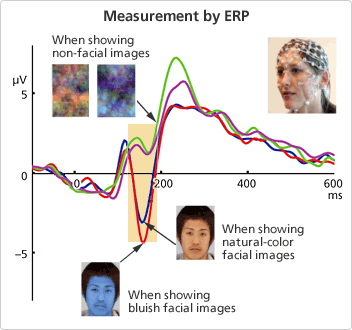
Toyohashi University of Technology's Visual Perception and Cognition Laboratory is engaged in research into the mechanisms by which human beings see and recognize objects. Human beings make judgments the instant they perceive the material of an object or a person's complexion. Yet the mechanisms which make this possible are yet to be fully understood. The Laboratory is engaged in discovering exactly what these mechanisms are and also researching technology which will distinguish objects which cannot be distinguished by the human eye. Some of the results of this research have already been put to practical use in the form of equipment. In the research that led to this equipment, Nikon's ELS-VIS "Equalized Light Source + Visible", which can generate light to order, has proved extremely useful.
Laboratory head Professor Shigeki Nakauchi describes in detail the research his team is currently engaged in.
From fundamentals to application—research with a consistent overall vision
Please tell us about the research objectives of the Visual Perception and Cognition Laboratory.
Traditionally, most of the research carried out at Toyohashi University of Technology has been into bioengineering. As part of this work, the Laboratory is engaged in research into human visual perception, concentrating on two key aspects: the fundamentals of visual perception and the application of vision science.
Fundamental research is research which uses a scientific approach to explain the mechanisms by which human beings see objects. Technological work based on this foundation is classified as applied research if it uses machines to emulate the processes by which human beings see objects, or makes objects that cannot be seen become visible.
However, there are now also many research topics that don't clearly fall into either the fundamental-research or applied-research category. Take, for example, the digital camera. I believe a fundamental issue with this product is the need to closely analyze users' perceptions—for example, what it is that human beings perceive as being beautiful when they are attempting to shoot a beautiful scene with a camera. Naturally, there is also a requirement for technological improvements, such as a higher pixel resolution, better optical performance, and an improved autofocus function.
Research into the fundamentals of human perception and cognition, and the technical-application aspect of research should be studied in an integrated fashion. In other words, the concepts under which the Laboratory operates are "Vision Science" and "Vision Technology."
Please describe visual perception.
As a human being casually looks at things in a daily life, his or her brain is performing various functions. The inter-relationship between these functions is extremely complex and there is a very great deal about it we still do not understand.
First there is the problem of how human beings distinguish between objects. For example, how do they judge material? From the instant that a human being sees an object, he or she will judge its material in as little as one-twentieth of a second. The person will also entertain other feelings about the object in view, such as whether he or she is comfortable with it, whether it is natural or unnatural, whether he or she likes or dislikes it, and whether it is clean or dirty.
These judgments and feelings are derived from a complex interaction involving visual perception and the brain. I believe that if light is shed on the nature of the mechanisms that produce these judgments and feelings, a deeper understanding will emerge that will enable machines to carry out certain operations which humans cannot perform and certain operations which humans perform by means of visual inspection.
What methods are you using to shed light on these matters and what kind of research topics are you pursuing?

- *ERP (Event-Related Potential)
EEG recorded as a reaction to an event
To give one example, we are investigating the inter-relationship between the following three factors when a person is shown an object: the object itself, the person's response to it, and the state of the brain at the time of response. By measuring changes in both brain waves and blood flow in the brain, we can gain a better understanding of the way the brain works, in particular which parts of the brain perform which activities.
An example research topic is the ability to recognize human faces. The most outstanding human visual recognition capability is the ability to recognize objects in three dimensions. Even more so, the ability to recognize human faces is described as being quite remarkable. A human being can identify another individual from the various horizontal and vertical angles of the face, and can even read minute changes in his or her expression or complexion.
In our investigative research into the mechanism of face processing, which is based on the activity of the brain, we studied how the human brain reacts to changes observed in the complexion of another person. This revealed that there are parts of the brain that are sensitive to changes in the human complexion. It also revealed the age in months from which babies who cannot yet speak, are able to recognize differences in another person's complexion.

